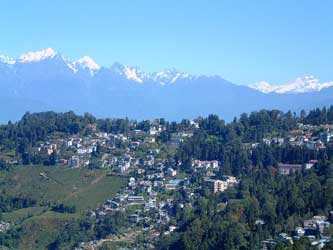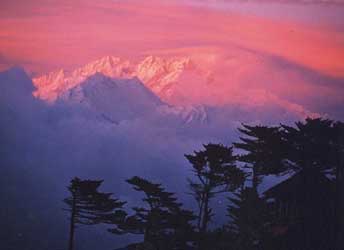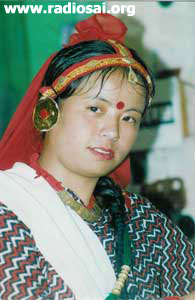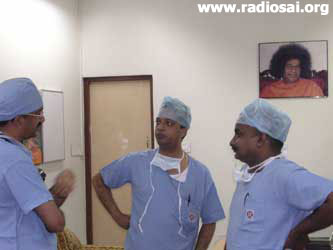 |
 |
 |
 |
| Volume 4 - Issue 11 NOVEMBER 2006 |
|
THE GIFT OF LIFE TO A GOOD HEART ...... Dazzling Darjeeling “The one land that all men desire to see, and having seen once, by even a glimpse, would not give that glimpse for the shows of the rest of the world combined.” These words expressed the feelings of Mark Twain when he visited Darjeeling.
Darjeeling is thought to be a derivation of “Dorjeeling,” meaning, the place of the Dorjee, the majestic thunderbolt of the Lamaist religion. The famous Buddhist monastery standing at the top of the Observatory hill was known by this name. Until the beginning of the eighteenth century, the district was part of the dominion of the Raja of Sikkim. Darjeeling and Kalimpong were independent kingdoms ruled by the kings of Sikkim, but in 1706 Kalimpong was conquered by the Bhutanese. In 1780, the Gorkhas invaded from Nepal and took Darjeeling . Later, the British defeated the Gorkhas and returned part of the land to the King of Sikkim, who operated under British protection. During this period, Darjeeling was recognized for its value as a sanatorium – where people went to regain their health – and also as a hill station. Politically and militarily, it was a key passage into Nepal and Tibet. The British coerced the King into handing over Darjeeling to the Crown and developed it to suit their needs. Eventually, the British annexed the whole of Bengal. By 1857, Darjeeling, which had been heavily forested and virtually uninhabitable, had roads, sanatoria, and 10,000 inhabitants. Nepalese laborers, recruited to work on the tea plantations established by the British in the 1840s, made up the bulk of the population. The vast majority still speak Nepali as their first language, and the name Darjeeling continues to be synonymous with tea.
Today, the Darjeeling Gorkha Hill Council (DGHC), with a large measure of autonomy from the West Bengal state government, governs the land. Darjeeling remains part of West Bengal but now has greater control over its own affairs. The Spirited Poonam Gurung The Gurung family hails from Darjeeling and can trace its ancestry to the original Nepalese immigrants who settled in West Bengal. Poonam Gurung is the second daughter of Shyam Gurung and Kamala Gurung.
Swami’s Hospital – A Ray of Hope Her family was convinced and she came to Prashanti Nilayam, the abode of the Lord she had worshipped since she was seven. Being part of the Samithi, she came as a seva dal volunteer and during the course of her stay underwent investigations into her malady. After performing catheterization on her, it was found that her mitral valve could be dilated, so a PTMC (Percutanious Trans Mitral Commissurotomy) was done in SSSIHMS PG in 2001 and the valve was dilated. She came with her sister Neelam this time, because it was mandatory that a helper accompany the patient. Before the dilation, she was having breathing trouble and would tire quickly and could not perform any heavy tasks. After the PTMC, her breathing problem was solved and she could get back to a near normal life.
The conversation Poonam and Pramod had with the cardiologist was the clincher. Till then they were on the fence, whether to go ahead with the operation or not. The cardiologist clearly explained the process and they decided to have the procedure done. At first they did not inform the parents but spoke to Poonam’s elder sister and brother-in-law. Concerned, the parents would be distressed if informed of the seriousness of the situation, the daughters told them it was only minor surgery. The parents gave their consent. Later on, after the surgery was successfully accomplished, the true nature was revealed. Poonam never felt any fear regarding the surgery. She had implicit faith that Swami would look after her and nothing untoward would happen. A Rare Blood Condition When she was admitted as an in-patient and the preoperative protocol was done, a surprising fact emerged. Poonam had an abnormal blood condition. It is common knowledge that blood is of four groups: A, B, AB and O. Within these four groups there is a factor called Rh factor, the presence or absence of which gives the nomenclature positive or negative. This is the primary differentiating factor but there are many more factors which have a bearing on blood transfusion. The details of blood types and their grouping are too complex to discuss here, but basically, different blood groups are incompatible and if they intermix, a biochemical reaction called clumping occurs where the blood forms blobs which look like clots. This can sometimes occur even if the blood is of the same group. So before blood is transfused to a patient, the patient’s blood sample is cross-matched with the donor’s sample. Usually it is not a problem to arrange for compatible blood. In some patients, the presence of cold agglutinins (a rare condition when blood temperature falls below normal body temperature and clots form – an irreversible condition with fatal consequences) creates clumping of cells at subnormal temperature. Still, we can do open-heart surgeries in such patients at normothermic cardiopulmonary bypass. This means we do not reduce the patient’s temperature on the heart-lung machine. Poonam’s case was unique. She had both warm and cold agglutinins, a very rare condition where the patient’s body totally rejects blood transfusions; she could not receive any transfusion because the body will react and clumping will occur immediately. Despite the best efforts of the blood bank officer, Dr. Nandita Ghoshal, not a single unit of A positive blood was found to be compatible with Poonam’s. This was reconfirmed at St. John’s hospital.
The Procedure is a “Go” After deliberation among the doctors and discussions with Poonam and her husband, it was decided to proceed with the surgery. Poonam donated her own blood on two occasions before the operation. This was stored in the blood bank.On the operating table, another unit of blood was collected minutes before the surgery. Using a combination of chemicals and a cell saver/auto transfusion set, the operation began. A mitral valve replacement was successfully performed followed by an uneventful postoperative recovery.
Poonam and Pramod – Singing and Smiling! Everything went as planned and the surgery was a success and Poonam had the best kind of recovery, an absolutely boring one, and was discharged after a short stay. Now she is back at her job in the General Hospital with the mechanical valve ticking away inside her stout heart. Perhaps it was the stoicism she inherited from her ancestors from Nepal, who came to the wild hills of West Bengal centuries ago; perhaps it was a maturity of mind and calmness of spirit that God had blessed her with; perhaps it was God himself, working through her as an instrument and an example to teach us all forbearance and sacrifice. Poonam’s case is yet another instance which teaches is that we “normal” people have to realize that a normal life is a miracle. Dear Reader, how did you like this story? Would you like more of such patient stories in this section of our magazine? Do you have any suggestions for our 'Healing Touch' section which will help you better? Please let us know at h2h@radiosai.org. Please mention your name and country when you write to us. – Heart2Heart Team |
| You can write to us at : h2h@radiosai.org |
Vol 4 Issue 11 - NOVEMBER 2006
|
Best viewed in Internet Explorer - 1024 x 768 resolution. |
DHTML Menu by Milonic. |








